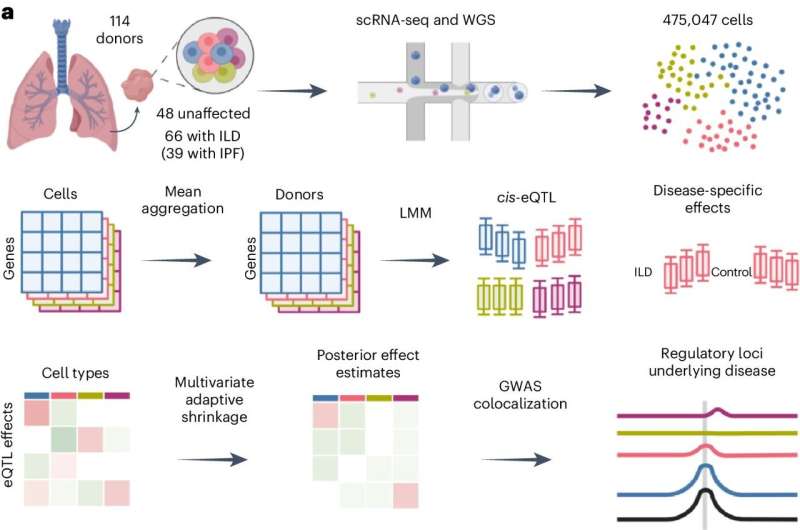This article has been reviewed according to Science X's editorial process and policies. Editors have highlighted the following attributes while ensuring the content's credibility:
fact-checked
peer-reviewed publication
trusted source
proofread
Scientists take a closer look at pulmonary fibrosis genetics

Regulators of gene expression are thought to play an outsized role in disorders from cancers to heart disease. But how exactly do variations in gene regulation translate into a disease's biology?
A team of scientists led by researchers from the Translational Genomics Research Institute (TGen), part of the City of Hope, together with investigators at St. Vincent's Institute of Medical Research and Vanderbilt University Medical Center, now have a better answer for this question when it comes to pulmonary fibrosis (PF), an incurable respiratory disease.
Their study, published in Nature Genetics, is the first to look at these variations at the cell type level across all cells within a solid tissue—in this case, the lung.
The findings will help researchers better understand what goes wrong in PF, said Nicholas Banovich, Ph.D., a TGen associate professor in the Integrated Cancer Genomics Division and co-senior author on the paper.
Pulmonary fibrosis is the end stage of a chronic and progressive lung disease. The most severe cases lead to death or the need for a lung transplant within three to five years. There are a few FDA-approved medications for PF, but they only moderately improve survival time, Banovich said.
"Through the past several years, it has become clear that genetic factors contribute substantially to a person's risk of developing pulmonary fibrosis," said Jonathan Kropski MD, Associate Professor of Medicine at Vanderbilt University Medical Center and co-senior author on the paper, "but how these genetic variations lead to disease has not been well understood."
"Our work is focused on understanding the molecular mechanisms that drive the disease so that we can start to think about therapeutics that would treat those mechanisms rather than treating the end-stage fibrosis," Banovich noted.
In lung tissue taken from 116 people, 67 of whom had PF, the TGen researchers looked at expression quantitative trait loci (eQTL), which are the genetic variations outside of genes that control gene expression, or how genes are turned on or off in a cell.
While previous studies have identified eQTL in the lung, these associations came from studies of bulk lung tissue, offering only an average or composite view of how gene expression is regulated in the lung.
More recently, there has been a big shift in trying to understand what genetic control of gene regulation looks like at the cell type level, across a large number of cells from a real organ system.
"The reason PF is a good candidate for this kind of approach is that the human lung is super complex, as its comprised of dozens of different cell types with discrete functions," said Banovich.
The approach used by the team mapped eQTL across 38 cell types in the lung. Most of the eQTL were shared across a cell lineage, and only a small fraction were specific to an individual cell type, the researchers found.
However, there was a class of eQTL that were found either only in healthy lung tissue or only in PF lung tissue, and those were highly cell type specific. This suggests that these gene regulators may be important contributors to chronic lung disease, the researchers noted.
eQTL related to PF risk were often found in epithelial cells that line the lungs and airways.
"Seeing that a lot of the genetic risk for the disease was localizing to these cells is strengthens a theory that this is where a lot of the action is happening in PF," said Banovich.
Davis McCarthy, DPhil, Head of Bioinformatics and Cellular Genomics at St Vincent's Institute of Medical Research and co-senior author on the paper, said, "The resolution and richness of the data generated demanded complex data analyses.
"The success of this international collaboration is a tribute to the close integration of clinical, genomic, and computational researchers within the team."
More information: Heini M. Natri et al, Cell-type-specific and disease-associated expression quantitative trait loci in the human lung, Nature Genetics (2024). DOI: 10.1038/s41588-024-01702-0





















